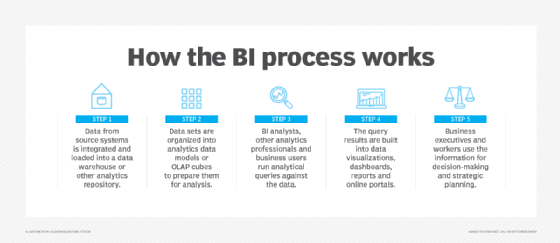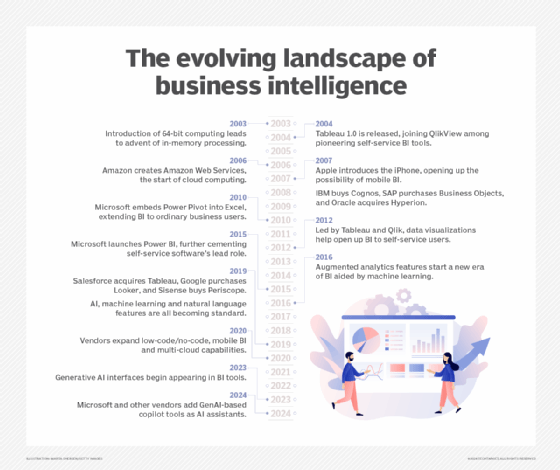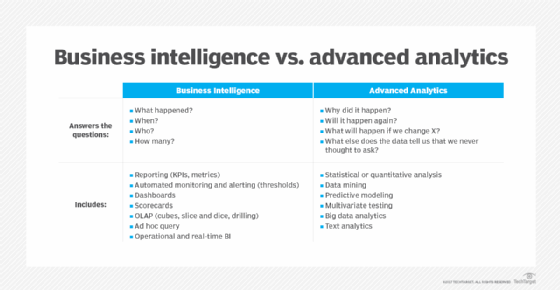According to Your Reading on Business Intelligence Solution, What Is the Second Stage of Data Flow?
Business intelligence (BI) is a engineering-driven process for analyzing data and delivering actionable data that helps executives, managers and workers make informed business decisions. As role of the BI process, organizations collect data from internal Information technology systems and external sources, ready it for analysis, run queries against the data and create data visualizations, BI dashboards and reports to make the analytics results available to business users for operational controlling and strategic planning.
The ultimate goal of BI initiatives is to bulldoze amend business decisions that enable organizations to increase revenue, improve operational efficiency and gain competitive advantages over business organization rivals. To achieve that goal, BI incorporates a combination of analytics, information management and reporting tools, plus various methodologies for managing and analyzing data.
How the business intelligence process works
A business intelligence compages includes more than than but BI software. Business intelligence data is typically stored in a data warehouse congenital for an entire organization or in smaller data marts that hold subsets of business information for individual departments and business units, often with ties to an enterprise data warehouse. In improver, data lakes based on Hadoop clusters or other big information systems are increasingly used as repositories or landing pads for BI and analytics data, peculiarly for log files, sensor data, text and other types of unstructured or semistructured data.
BI data can include historical information and real-time information gathered from source systems as it's generated, enabling BI tools to support both strategic and tactical decision-making processes. Earlier it's used in BI applications, raw data from different source systems generally must be integrated, consolidated and cleansed using data integration and data quality management tools to ensure that BI teams and business organisation users are analyzing accurate and consistent information.
From at that place, the steps in the BI procedure include the following:
- data preparation, in which information sets are organized and modeled for analysis;
- analytical querying of the prepared data;
- distribution of key functioning indicators (KPIs) and other findings to business users; and
- use of the data to help influence and bulldoze business decisions.
Initially, BI tools were primarily used past BI and IT professionals who ran queries and produced dashboards and reports for business users. Increasingly, however, business analysts, executives and workers are using business intelligence platforms themselves, cheers to the development of self-service BI and information discovery tools. Self-service business intelligence environments enable business users to query BI information, create data visualizations and design dashboards on their own.
BI programs often incorporate forms of advanced analytics, such as data mining, predictive analytics, text mining, statistical assay and big information analytics. A common example is predictive modeling that enables what-if analysis of different business concern scenarios. In most cases, though, advanced analytics projects are conducted past separate teams of data scientists, statisticians, predictive modelers and other skilled analytics professionals, while BI teams oversee more straightforward querying and analysis of business data.

Why business organization intelligence is important
Overall, the office of business concern intelligence is to ameliorate an organisation's business operations through the employ of relevant data. Companies that effectively utilize BI tools and techniques can translate their nerveless information into valuable insights about their business organization processes and strategies. Such insights can and so exist used to make better business decisions that increase productivity and revenue, leading to accelerated business growth and higher profits.
Without BI, organizations can't readily accept advantage of information-driven decision-making. Instead, executives and workers are primarily left to base of operations of import concern decisions on other factors, such every bit accumulated knowledge, previous experiences, intuition and gut feelings. While those methods tin can result in good decisions, they're also fraught with the potential for errors and missteps because of the lack of data underpinning them.
Benefits of concern intelligence
A successful BI program produces a variety of business organization benefits in an organization. For example, BI enables C-suite executives and department managers to monitor business functioning on an ongoing basis so they can deed quickly when problems or opportunities arise. Analyzing customer data helps brand marketing, sales and customer service efforts more than constructive. Supply chain, manufacturing and distribution bottlenecks can be detected before they crusade financial harm. Hour managers are ameliorate able to monitor employee productivity, labor costs and other workforce data.
Overall, the key benefits that businesses can become from BI applications include the power to:
- speed up and improve decision-making;
- optimize internal business processes;
- increase operational efficiency and productivity;
- spot business problems that need to be addressed;
- identify emerging business and market trends;
- develop stronger concern strategies;
- drive college sales and new revenues; and
- gain a competitive edge over rival companies.
BI initiatives also provide narrower business benefits -- among them, making it easier for projection managers to track the condition of business organisation projects and for organizations to gather competitive intelligence on their rivals. In addition, BI, data management and Information technology teams themselves benefit from business organization intelligence, using it to analyze various aspects of technology and analytics operations.
Types of business concern intelligence tools and applications
Business intelligence combines a broad fix of data assay applications designed to see different information needs. Most are supported by both cocky-service BI software and traditional BI platforms. The listing of BI technologies that are available to organizations includes the post-obit:
Advertizing hoc assay . Also known equally advertisement hoc querying, this is one of the foundational elements of modern BI applications and a central feature of self-service BI tools. It's the process of writing and running queries to analyze specific business issues. While ad hoc queries are typically created on the wing, they often end upward beingness run regularly, with the analytics results incorporated into dashboards and reports.
Online analytical processing (OLAP). One of the early BI technologies, OLAP tools enable users to analyze information forth multiple dimensions, which is specially suited to complex queries and calculations. In the past, the information had to exist extracted from a data warehouse and stored in multidimensional OLAP cubes, merely it's increasingly possible to run OLAP analyses directly confronting columnar databases.
Mobile BI . Mobile business organisation intelligence makes BI applications and dashboards bachelor on smartphones and tablets. Often used more to view data than to analyze it, mobile BI tools typically are designed with an emphasis on ease of apply. For instance, mobile dashboards may only brandish 2 or three data visualizations and KPIs so they tin hands exist viewed on a device's screen.
Real-time BI . In real-time BI applications, information is analyzed as it's created, collected and processed to give users an up-to-date view of concern operations, customer behavior, financial markets and other areas of interest. The real-time analytics process often involves streaming data and supports decision analytics uses, such as credit scoring, stock trading and targeted promotional offers.
Operational intelligence (OI). As well called operational BI, this is a form of real-time analytics that delivers information to managers and frontline workers in business organisation operations. OI applications are designed to assist in operational decision-making and enable faster activity on issues -- for example, helping call centre agents to resolve problems for customers and logistics managers to ease distribution bottlenecks.
Software-as-a-service BI . SaaS BI tools utilize deject computing systems hosted past vendors to deliver data assay capabilities to users in the form of a service that'south typically priced on a subscription basis. Also known as cloud BI, the SaaS option increasingly offers multi-cloud support, which enables organizations to deploy BI applications on different deject platforms to encounter user needs and avoid vendor lock-in.
Open source BI (OSBI). Business intelligence software that is open up source typically includes two versions: a community edition that can exist used free of charge and a subscription-based commercial release with technical support by the vendor. BI teams can as well admission the source lawmaking for development uses. In addition, some vendors of proprietary BI tools offer free editions, primarily for individual users.
Embedded BI . Embedded concern intelligence tools put BI and information visualization functionality directly into concern applications. That enables business users to analyze data within the applications they employ to do their job. Embedded analytics features are most usually incorporated past application software vendors, but corporate software developers can also include them in homegrown applications.
Collaborative BI . This is more than of a process than a specific technology. It involves the combination of BI applications and collaboration tools to enable unlike users to piece of work together on information assay and share information with i some other. For example, users tin annotate BI data and analytics results with comments, questions and highlighting via the use of online chat and discussion tools.
Location intelligence (LI). This is a specialized class of BI that enables users to analyze location and geospatial information, with map-based data visualization functionality incorporated. Location intelligence offers insights on geographic elements in business information and operations. Potential uses include site pick for retail stores and corporate facilities, location-based marketing and logistics management.
Business intelligence vendors and market
Self-service BI and data visualization tools have become the standard for modern BI software. Tableau, Qlik and Spotfire, which is now part of Tibco Software, took the lead in developing self-service engineering early and became prominent competitors in the BI market by 2010. Nearly vendors of traditional BI query and reporting tools have followed in their path since and then. Now, virtually every major BI tool incorporates cocky-service features, such every bit visual information discovery and advertisement hoc querying.
In improver, mod BI platforms typically include:
- information visualization software for designing charts and other infographics to evidence data in an easy-to-grasp manner;
- tools for building BI dashboards, reports and performance scorecards that brandish visualized information on KPIs and other business organisation metrics;
- data storytelling features for combining visualizations and text in presentations for concern users; and
- usage monitoring, functioning optimization, security controls and other functions for managing BI deployments.
BI tools are bachelor from dozens of vendors overall. Major Information technology vendors that offering BI software include IBM, Microsoft, Oracle, SAP, SAS and Salesforce, which bought Tableau in 2019 and as well sells its own tools adult before the acquisition. Google is also in the BI market through its Looker unit of measurement, acquired in 2020. Other notable BI vendors include Alteryx, Domo, GoodData, Infor Birst, Data Builders, Logi Analytics, MicroStrategy, Pyramid Analytics, Sisense, ThoughtSpot and Yellowfin.
While full-featured BI platforms are the most widely used business intelligence engineering, the BI marketplace likewise includes other production categories. Some vendors offer tools specifically for embedded BI uses; examples include GoodData and Logi Analytics. Companies similar Looker, Sisense and ThoughtSpot target complex and curated information analysis applications. Various dashboard and data visualization specialists focus on those parts of the BI process; other vendors specialize in information storytelling tools.
Examples of business intelligence utilise cases
In general terms, enterprise BI employ cases include:
- monitoring business operation or other types of metrics;
- supporting decision-making and strategic planning;
- evaluating and improving concern processes;
- giving operational workers useful information about customers, equipment, supply chains and other elements of business operations; and
- detecting trends, patterns and relationships in data.
Specific use cases and BI applications vary from manufacture to industry. For example, fiscal services firms and insurers apply BI for risk assay during the loan and policy approval processes and to identify boosted products to offer to existing customers based on their current portfolios. BI helps retailers with marketing campaign management, promotional planning and inventory management, while manufacturers rely on BI for both historical and real-time analysis of plant operations and to aid them manage production planning, procurement and distribution.
Airlines and hotel chains are big users of BI for things such every bit tracking flight capacity and room occupancy rates, setting and adjusting prices, and scheduling workers. In healthcare organizations, BI and analytics assistance in the diagnosis of diseases and other medical conditions and in efforts to improve patient care and outcomes. Universities and school systems tap BI to monitor overall student performance metrics and identify individuals who might need assistance, amongst other applications.
Business organisation intelligence for big information
BI platforms are increasingly being used equally front-end interfaces for big data systems that comprise a combination of structured, unstructured and semistructured data. Modern BI software typically offers flexible connectivity options, enabling it to connect to a range of data sources. This, along with the relatively simple user interface (UI) in well-nigh BI tools, makes it a good fit for big information architectures.
Users of BI tools tin can admission Hadoop and Spark systems, NoSQL databases and other big data platforms, in addition to conventional data warehouses, and get a unified view of the various data stored in them. That enables a broad number of potential users to become involved in analyzing sets of big information, instead of highly skilled data scientists existence the only ones with visibility into the data.
Alternatively, big data systems serve as staging areas for raw data that later is filtered and refined and then loaded into a information warehouse for analysis by BI users.
Concern intelligence trends
In addition to BI managers, business intelligence teams generally include a mix of BI architects, BI developers, BI analysts and BI specialists who work closely with data architects, data engineers and other data management professionals. Business organisation analysts and other terminate users are also often included in the BI development procedure to correspond the business side and brand sure its needs are met.
To aid with that, a growing number of organizations are replacing traditional waterfall development with Agile BI and data warehousing approaches that use Agile software development techniques to suspension up BI projects into small chunks and evangelize new functionality on an incremental and iterative basis. Doing then enables companies to put BI features into use more quickly and to refine or alter development plans equally business needs alter or new requirements emerge.
Other notable trends in the BI marketplace include the post-obit:
- The proliferation of augmented analytics technologies . BI tools increasingly offer natural language querying capabilities every bit an alternative to writing queries in SQL or another programming linguistic communication, plus AI and machine learning algorithms that assist users find, understand and prepare data and create charts and other infographics.
- Depression-code and no-lawmaking development. Many BI vendors are also adding graphical tools that enable BI applications to be developed with niggling or no coding.
- Increased use of the cloud. BI systems initially were slow to motion to the cloud, partly considering information warehouses were primarily deployed in on-premises data centers. Simply cloud deployments of both data warehouses and BI tools are growing; in early on 2020, consulting firm Gartner said most new BI spending is now for deject-based projects.
- Efforts to improve data literacy . With self-service BI broadening the use of business intelligence tools in organizations, it's disquisitional to ensure that new users tin understand and work with information. That's prompting BI teams to include data literacy skills in user training programs. BI vendors accept also launched initiatives, such equally the Qlik-led Data Literacy Project.

Business intelligence vs. data analytics and business analytics
Sporadic use of the term business intelligence dates back to at to the lowest degree the 1860s, but consultant Howard Dresner is credited with first proposing information technology in 1989 as an umbrella phrase for applying data analysis techniques to back up business concern decision-making processes. What came to exist known as BI tools evolved from earlier, oft mainframe-based analytics technologies, such every bit decision support systems and executive data systems that were primarily used by business executives.
Business intelligence is sometimes used interchangeably with business analytics. In other cases, business analytics is used either more narrowly to refer to advanced analytics or more broadly to include both that and BI. Meanwhile, data analytics is primarily an umbrella term that encompasses all forms of BI and analytics applications. That includes the main types of data analysis: descriptive analytics, which is typically what BI provides; predictive analytics, which models future behavior and outcomes; and prescriptive analytics, which recommends business actions.

Source: https://www.techtarget.com/searchbusinessanalytics/definition/business-intelligence-BI
0 Response to "According to Your Reading on Business Intelligence Solution, What Is the Second Stage of Data Flow?"
Post a Comment